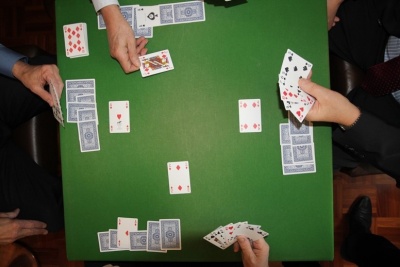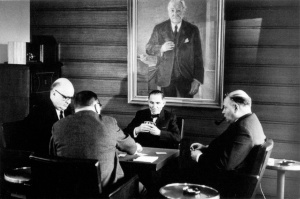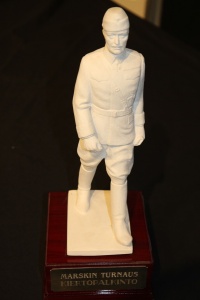Playing skruuvi, a Finnish card game
| Playing skruuvi, a Finnish card game | ||||
|---|---|---|---|---|
| In the national inventory | ||||
|
Practitioners and people who know the tradition well
Skruuvi – the Finnish whist-bridge – is a fascinating trick-taking card game that has been played in Finland close to 150 years. The first guidebook to skruuvi was published some 120 years ago, in 1895.

Skruuvi is currently played at clubs in Helsinki, Kuopio, and Mikkeli together with other cities such as Hamina, Valkeakoski and Lappeenranta. Skruuvi has been played at the Helsinki Finnish Club since the founding of the Club in 1876, and this tradition continues strongly at present. The Helsinki Finnish Club has organized since 2012 annual ”Skruuvi Academy” courses for beginners, in which seasoned players have taught and supervised the students both in theory and practice. This has resulted in a significant increase in the number of active players at the Club, the number is currently over 50. Active recruitment and training of new players take place also in Kuopio, Mikkeli, and Hamina. Nation-wide activities of the skruuvi players involve a plethora of tournaments, such as the traditional Toro tournament at the Helsinki Finnish Club, the Puijo tournament in Kuopio, the biennial tournament in the Mikkeli Club to commemorate the Marshal of Finland, and annual Skruuvi Championship Tournaments in Finland. A large number of four-member partnerships play skruuvi actively on a weekly basis in the cities mentioned above; for example, the number of these partnerships is currently nine at the Helsinki Finnish Club. In addition to the active skruuvi players at clubs, skruuvi is being played on a regular basis also at homes by families and friends, and the number of skruuvi players in Finland is currently several hundreds.
Practising of the tradition
Skruuvi is a trick-taking game that is played with an ordinary deck of 52 cards without jokers by four players in two competing partnerships, with the players facing each other at the table forming a team and being partners. The other two players are their opponents. The initial seating arrangement of the players does not matter, since each player will partner every other one in succession. The partners share the points won or lost in a session. There are three different forms of playing in skruuvi – kitty games, no kitty games, and bolshevik – and four different types of playing – trumps, grand (no trump), misère and all-pass misère. Like bridge, skruuvi involves auction (bidding). The auction begins immediately after the cards have been dealt. It is a process that comprises strict procedural and ethical protocols for the players to describe cards in their hands, in order to determine the declaring side and the final contract.
In kitty games, four cards are dealt to the middle of the table face down as the kitty, and the players are therefore forced to bid in the auction without knowing the final cards in hand. No kitty games are played without the four-card kitty, and the lowest possible final contract in no kitty games is at six-level; in other words, the main players need to win 12 tricks (in trumps or grand) or only one trick (in misère). Should none of the players bid in the first round of auction in kitty and no kitty games, all-pass misère will be played. This latter form of playing – all-pass misère – cannot be bid separately. In trumps, the trump suit is determined by the main players during bidding. By contrast, there is no trump suit in grand, in which form of playing the trick is won by the highest cards in the suit led. The goals in misère are to avoid winning tricks and to play aces to the tricks won by the opponents.
Each bid in the auction must surpass – that is, be higher than – the previous bid in either the denomination or the level. The level of the game is indicated by a number from one to seven. In trumps and grand, it depicts the number of tricks in excess of six that the main players aim at winning (e.g., a bid of five diamonds necessitates the main players to win at least 11 tricks). In misère, it refers to the number of tricks less than seven that the main players aim at winning (e.g., a bid of five misère will permit the main players to win at most two tricks).
Bolshevik is a unique form of playing in skruuvi, in that one player plays then against the other three players and has a contract of no tricks at all, while the opponents team up and try to prevent the bolshevik player from making the contract. As a rule of thumb, bolshevik is included only when all players agree to play it.
A complete play comprises three sessions, during which a player teams up and opposes in succession with the other three. Thus, all players participate actively in each deal. Each session comprises four kitty and four no kitty games and, if so agreed ahead of time, a bolshevik for each partner. Upon completion of a session, the players change seats. A three-session, complete play comprises thus 24 deals, providing that bolshevik has not been played.
Skruuvi is a very social card game with good-humored camaraderie among the players. Cheerful laughing and live conversations are typical features at skruuvi tables – however, bids in auctions and playing tricks follow strictly the rules and regulations of the game. Skruuvi is also a very complex game with more alternatives than in other card games. The element of risk is always present in skruuvi, and undoubtedly, skruuvi teaches the players to analyze and manage risks.
The background and history of the tradition

Skruuvi is a fascinating trick-taking card game that has been played in Finland close to 150 years. Its origin is the same as that of bridge, the English whist. An intermediate between whist and skruuvi was the Russian vint that appears to be extinct.
Skruuvi’s predecessor vint is a card game developed from whist and Russian preference in the latter half of the 19th century in St. Petersburg. It became a very popular trick-taking card game in Finland while the country was an autonomous part of Russia (Grand Duchy of Finland in 1809–1917). Vint arrived in Finland in the 1870s, most likely with the officers who had served in the Imperial Russian army. Only trump and no trump games were initially played in vint, and there was just one round of bidding.
When the Finns started to amend the rules of vint, they renamed the game as skruuvi. The first guidebook to skruuvi (”Regler för skruf-whist”) was published in 1895 in Turku. The first Finnish guidebook to skruuvi was appeared in 1903. Already at that time, the kitty was added to the game. The highest bidder took a kitty of four cards and gave one card to every other player. Or alternatively, s/he gave four cards to his/her partner who, in turn, gave one card to all other players. These card exchange features rendered skruuvi clearly distinct of vint or bridge.
All-pass misère became part of skruuvi at the end of the 19th century; this form of playing ensues when all players pass in the first round of bidding. Each of the four players has an active role in skruuvi and plays with his/her cards in hand as opposed to, for example, bridge in which game the declarer's partner is a dummy, whose cards are exposed on the table after the opening lead and played by the declarer. All these developments in the rules of skruuvi rendered the game highly multi-faceted, involving among other things expertise in risk taking and risk control as opposed to bridge, in which a sophisticated bidding system and management of statistical odds are the main features of the game.

In the early 20th century, skruuvi developed into a more and more challenging game of strategy. For example, the opponents were permitted to double and the main players redouble; the tricks taken by aces became countable; and it was made possible to declare misère as the final contract. Around the same time in the 1920s, two other forms of playing were added to skruuvi: no kitty games and bolshevik. In the former, a contract of at least 12 tricks has to be declared already in the first-round auction. In the bolshevik, a single player plays against the three other players with a contract of seven misère – that is, no tricks at all are permitted –, while the opponents aim at preventing this from happening. The end result of all these developments is that skruuvi is indeed a unique Finnish card game.
There are many significant differences between skruuvi and bridge. For example, skruuvi has rotating partners as opposed to fixed two-player partnership in bridge. Kitty and card exchange are not present in bridge. All players participate actively in skruuvi, that is, there is no dummy as in bridge. There are multiple forms of playing in skruuvi (misère, kitty games, bolshevik) that do not belong to bridge. Skruuvi is also more versatile than bridge, and its playing involves analysis and control of risks rather than mathematical counting.
Skruuvi became a popular trick-taking card game in Finland early in the 20th century, but with increasing number of players in various regions of the country, playing rules and habits started to diverge. The rules of skruuvi were codified in early 1940s in two separate guidebooks written by pseudonyms O.L. (1942) and E. N. Maalari (1944). The main purpose of these guidebooks written by experienced skruuvi players was to make the rules of the game uniform and to solidify the scoring systems, both of which had become somewhat variable in preceding years among different playing parties in Finland. However, the scoring system remained complicated and involved a number of specific features, such as the number of honors, the sequence of touching honors, opening leads, etc. The players at the Helsinki Finnish Club eventually simplified the scoring system in the 1950s.
Throughout its history, skruuvi has developed into a unique Finnish trick-taking, tactical card game. When playing skruuvi, one has to concentrate, possess good memory and be observant – the faculties that are all improved by playing skruuvi. Skruuvi has been played by members of the Helsinki Finnish Club since the founding of the club (1876), and this tradition has continued strongly up until today. Professor Arvo Ylppö (1887–1992), a long-time Archiater (the honorary chief of all physicians in Finland), was a legendary skruuvi enthusiast who continued playing this game past his 100th birthday. Minna Canth (1844–1897), the famous suffragette and writer in Finland, was a well-known female skruuvi player.
The transmission of the tradition

The Helsinki Finnish Club has organized since 2012 annual “Skruuvi Academy” courses chaired by Kari Bergholm and Jaakko Karvonen with the help of seasoned skruuvi players at the Club. Active players in Kuopio, Mikkeli and Hamina have also held training sessions to new players. Starting in 2016, the Helsinki Finnish Club has extended the “Skruuvi Academy” courses to outside of Helsinki – initially in Hamina followed by Mikkeli and Kuopio. Through organization of coordinated events and happenings both in Finland (e.g., monthly skruuvi tournaments at the Helsinki Finnish Club) and abroad (e.g., the Tallinn tournament, a week-long skruuvi camp in Salo, Italy), it has been possible to recruit and train new players and to develop their playing skills.
The art of playing skruuvi and the way by which the game is being developed have been taken care of by new guidebooks published in the 21st century. Hannu Taskinen published a book entitled “Skruuvi” in 2004 that described the scoring system devised by players at the Helsinki Finnish Club in the 1950s. Unfortunately, the distribution of this booklet was very limited. A guidebook to skruuvi (“Skruuviopas” in Finnish), edited by Kari Bergholm, was published by the Helsinki Finnish Club in 2013. This guidebook described in a systematic and illustrative fashion the current features of skruuvi – rules and regulations together with forms and types of playing – and guided uninitiated players to the current practices and strategies of playing. The booklet turned out to be a very useful guide to new players. Seasoned players at the Helsinki Finnish Club edited a more comprehensive handbook of skruuvi in 2016, both in Finnish (“Skruuvin käsikirja”) and in English (”Handbook of Skruuvi – the Finnish Whist–Bridge”); these books were officially released on October 27, 2016.

The future of the tradition
The number of active players at the heyday of skruuvi in early–mid 20th century is unfortunately not known. Nevertheless, the practices mentioned above – new guidebooks, annual training events (e.g. Skruuvi Academy courses) and various tournaments and coordinated happenings for the players from different cities in Finland – have promoted skruuvi and resulted in a significant and manifold increase in the number of active skruuvi players. For example, the number of active weekly players at the Helsinki Finnish Club is currently some 50. The total number of active weekly players is similar in other cities mentioned above. These numbers combined to those playing skruuvi at home with families and friends indicate that the number of skruuvi players is currently several hundred in Finland. And it is very encouraging that new players are of younger generation and represent a variety of occupations.
The current training events and their forthcoming extensions are likely to ensure a bright future for skruuvi and will be of great importance for securing continuation of this unique and fascinating Finnish trick-taking card game also among new generations. The newest handbooks of skruuvi have been written both in Finnish and English. Time will tell whether or not this unique Finnish card game will also generate interest outside of Finland in years to come.
The community/communities behind this submission.
Bibliography and links to external sources of information
Internet
Literature
(Anonymous) 1985. Regler för skruf-whist. Turku.
(Anonymous) 1903. Opas ”skruf whist” peliin aloitteleville. Pori.
(Anonymous) 1912. Hjälpreda vid skruf whist-spel för nybegynnare. Tampere.
Bergholm, Kari 2013. Skruuviopas. Helsinki: Unigrafia.
Maalari, E. N. (Ensio Nordström) 1944. Uusi täydellinen skruuvipelin ohjekirja. Hämeenlinna.
Meretoja, Olli & Karvonen, Jaakko 2015. Skruuvi kiristyy – katsaus lähes sukupuuttoon kuolleen pelin pelastamisesta. Duodecim 131: 2279–2283.
Nyrkiö (Nygren), Johannes 1939. Skruuvipeli. Hamina. (Manuscript had printing agreement with a major publishing house, but it was never printed owing to the Winter War in Finland in 1939–1940.)
O.L. (Osmo Lehtosuo) 1943. Skruuvi-opas. Lahti: Akateeminen kirjakauppa.
Parlett, David 1992. Dictionary of Card Games. Oxford University Press. (Skruuvi is included in the description of vint.)
Taskinen, Hannu 2004. Skruuvi. Turku: Enostone oy.
The Helsinki Finnish Club 2016. Handbook of Skruuvi – The Finnish Whist-Bridge. Forssa Print.
